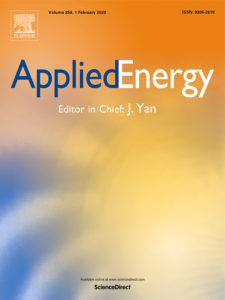Assessing new transmission and energy storage in achieving increasing renewable generation targets in a regional grid
Assessing new transmission and energy storage in achieving increasing renewable generation targets in a regional grid
- September 2019
- Peer-Reviewed Articles
- Multiple
 Conlon, T., Waite, M., & V. Modi. (2019). Assessing new transmission and energy storage in achieving increasing renewable generation targets in a regional grid. Applied Energy, 250, 1085-1098.
Conlon, T., Waite, M., & V. Modi. (2019). Assessing new transmission and energy storage in achieving increasing renewable generation targets in a regional grid. Applied Energy, 250, 1085-1098.
ABSTRACT: This study evaluates generation, transmission, and storage capacity needs to achieve deep renewable energy penetration in a regional electricity grid with an average load of approximately 20 GW. Increasing renewable energy targets are analyzed to evaluate the effects of realistic regional transmission upgrade and energy storage cost assumptions on the cost-optimal mix of generation, transmission, and storage capacity. Contextual data is used for New York State’s grid to examine how electricity generation from renewable energy resources (wind, water, and solar power) can meet between 50% and 80% of electricity demand. A central finding of the study is that when realistic transmission upgrade costs are assumed, new interzonal transmission and battery storage are not needed to cost effectively meet near-term renewable energy goals. In fact, New York can achieve 50% renewable energy penetration with only a buildout of new generation capacity: Onshore wind (13.7 GW), offshore wind (4.1 GW), and solar photovoltaics (3 GW). The presence of grid-scale battery storage, electric vehicles, or additional behind-the-meter solar capacity does not markedly change the model-selected generation mix. To achieve the 50% target, we compute a $52/MWh levelized cost of electricity for new renewable energy, which is in line with current generation costs.
As the renewable generation target increases beyond 50%, the model begins to select transmission upgrades and new storage capacity, the latter particularly if battery costs continue to decline as anticipated. At deeper targets, marginal generation capacity would otherwise experience high curtailment primarily due to supply–demand imbalances; we calculate the value of energy storage at a 65% renewable energy penetration level to be 2.5–3 times higher than its value at a 50% level. However, the additional storage and generation – and transmission, to a lesser degree – needed to achieve longer-term renewable energy goals lead to a substantial rise in total investment. Between 50% and 55% targets, the computed marginal levelized cost of electricity for new variable renewable energy is $94/MWh, compared to $592/MWh between 75% and 80%, suggesting alternative integration measures are likely necessary at such high penetration rates.




